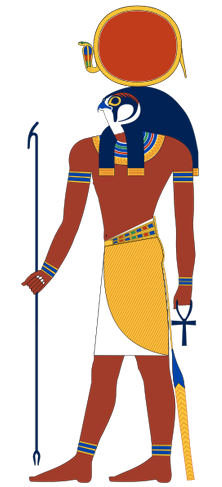

In one of his many forms, Ra has the head of a falcon and the sun-disk of Wadjet resting on his head.
Ra (pronounced as Rah, and sometimes as Ray) is an ancient Egyptian sun god. By the fifth dynasty he became a major deity in ancient Egyptian religion, identified primarily with the mid-day sun, with other deities representing other positions of the sun. Ra changed greatly over time and in one form or another, much later he was said to represent the sun at all times of the day.
The chief cult centre of Ra first was based in Heliopolis (ancient Inunu) meaning "City of the Sun." In later Egyptian dynastic times, Ra was merged with the god Horus, as Re-Horakhty (and many variant spellings). When his worship reached this position of importance in the Egyptian pantheon, he was believed to command the sky, the earth, and the underworld.
He was associated with the falcon, the symbol of other sun deities who protected the pharaohs in later myths. After the deities were paired with pharaohs, the children of Hathor were considered to be fathered by Ra.
Although not the contemporary view, E. A. Wallis Budge (1857-1934) claims that Ra was the one god of Egyptian monotheism, of which all other deities were aspects, manifestations, phases, or forms.
Ra should be pronounced as 'rei'; hence the alternative spelling Re rather than Ra. The meaning of Ra's name is uncertain, but it is thought if not a word for 'sun' it may be a variant of or linked to 'creative'. As his cult arose in the Egyptian pantheon, Ra often replaced Atum as the father, grandfather, and great-grandfather of the deities of the Ennead, and became a creator of the world.
Up until the mid-twentieth century, theories of Egyptologists postulated that the Heliopolis priesthood established this pesedjet at Heliopolis in order to place their local sun-god Ra above all other deities such as Osiris. Many Egyptologists now question this.
It appears almost certain, rather, that the Great Ennead - the nine deities of Atum, Geb, Isis, Nut, Osiris, Nephthys, Seth, Shu, and Tefnut - first appeared during the decline of Ra's cult in the sixth dynasty, and that after introduction of the new pesedjet the cult of Ra soon saw a great resurgence until the worship of Horus gained prominence.
Afterward worship focused on the syncretistic solar deity Ra-harakhty (Ra, who is Horus of the Two Horizons). During the Amarna Period of the eighteenth dynasty, Akhenaten introduced worship of another solar deity Aten. The deified solar disc represented his preferred regional deity as he attempted to lessen the influence of the temple of Atum. He built the Wetjes Aten (Elevating the Sun-disca) temple in Annu. Blocks from this temple later were used to build walls to the medieval city of Cairo and are included in some of the city gates. The cult of the Mnevis bull, an embodiment of Ra, had its centre here and established a formal burial ground for the sacrificed bulls north of the city.
In the later myths Ra was seen to have created Sekhmet, the early lioness war goddess who becomes Hathor, the cow goddess after she has sufficiently punished mankind as an avenging Eye of Ra.
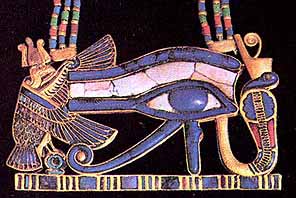
This changes the themes of much earlier myths into aspects of his and he is often said to be the father of both, and brother, to the god Osiris. Afterward nearly all forms of life supposedly were created only by Ra, who called each of them into existence by speaking their secret names and eventually humans were created from Ra's tears and sweat, hence the Egyptians call themselves the "Cattle of Ra."
Ra shared many of his symbols with other solar deities, in particular Horus, usually depicted as a falcon. In artwork Ra primarily is depicted as a man wearing a pharaoh's crown (a sign of his leadership of the deities) and the wadjet sun disk above his head. Often he had a falcon's head, as does Horus. In later myths about Ra, the sun is portrayed differently according to the position of the sun in the sky.
This was an early theme in Egyptian myths, with different names assigned to the sun depending upon its position in the sky. At sunrise he was the young boy Khepri, at noon the falcon-headed man Harakhty, and at sunset the elder Atum. This constant aging was suggested by some later Egyptians as the reason Ra stayed separate from the world and let Osiris or Horus rule in his place. This idea often is coupled with the myth in which Isis is able to trick an elderly Ra, having ruled on earth as a human pharaoh, into revealing his secret name, and thus the secret of his power. Ra subsequently lost his power, resulting in the cult of Isis and Osiris to rise in importance.
The Bennu bird (Phoenix) is Ra's ba and a symbol of fire and rebirth. The wadjet sun disk, also shown as the hieroglyphic Ankh, symbolizes the life given by the sun.
Obelisk represents the rays of the sun and was worshiped as a home of a solar god. Pyramids, aligned east to west, Falcon; Bull; a cobra commonly seen wrapped around the sun disk, the form of the goddess Wadjet, who often was depicted as an Egyptian cobra, an animal thought only to be female and reproducing through parthenogenesis.
Some traditions relate that the first wadjet was created by the goddess Isis who formed it from the dust of the earth and the spittle of Atum. The uraeus was the instrument with which Isis gained the throne of Egypt for her husband Osiris. As the sun, Ra was thought to see everything.
Together with Atum, Ra was believed to have fathered Shu and Tefnut who in turn bore Geb and Nut. These in turn were the parents of Osiris, Isis, Set (also known as Seth), and Nephthys. All nine made up the Heliopolitan Ennead.
For the Egyptians, the sun represented light, warmth, and growth. This made sun deities very important to Egyptians, and it is no coincidence that the sun came to be the ruler of all. In his myths, the sun was either seen as the body or Eye of Ra.
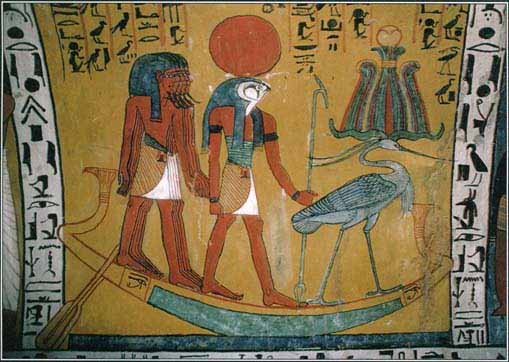
in his solar barque,
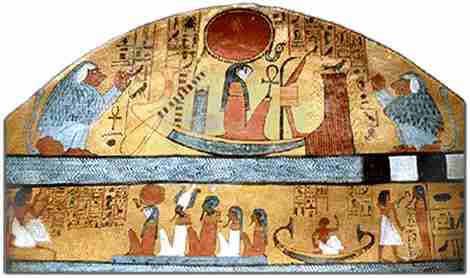
a journey he undertakes every night
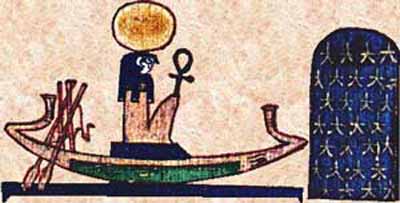
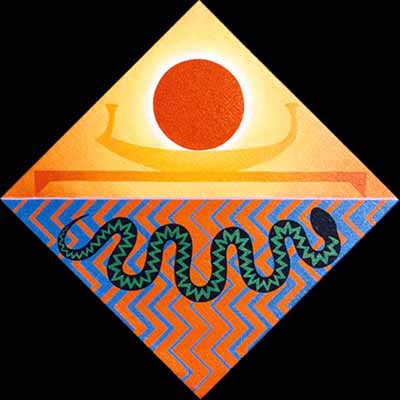
Ra was thought to travel in a sun boat (The Boat of the Millions) to protect its fires from the primordial waters of the underworld it passed through during the night. Ra traveled in the sun boat with various other deities including Set and Mehen who defended against the monsters of the underworld, and Ma'at who guided the boat's course. The monsters included Apep, an enormous serpent who tried to stop the sun boat's journey every night by consuming it. The Ra myth saw the sunrise as the rebirth of the sun by the goddess Nut and the sky, thus attributing the concept of rebirth and renewal to Ra and strengthening his role as a creator god.
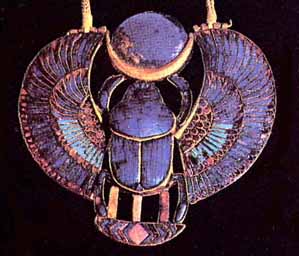
In the Pyramid Text, Re is perpetually resurrected in the mornings in the form of a scarab beetle, Khepri, which means the Emerging One. He rides on the primordial waters, called Nun, in his sacred bark (boat) along with a number of other deities across the sky, where at sunset he becomes Atum, the "All Lord". At sunset, he is swallowed by the goddess Nut, who gives birth to him each morning again as Khepri. Therefore, the cycle continued with birth, life and death.
Early in his myths Ra was said to be married to Hathor and they were the parents of Horus. Later his myths changed Hathor into Ra's daughter. This featured prominently in the myth often called The Story of Sekhmet, in which Ra sent Hathor down to punish humanity as Sekhmet.
Ra had 4 children:
Nut (sky) - Shu - Tefnut - Geb (Earth)
Nut and Geb created 4 children:
Set- Osiris - Isis - Nephthys
Isis and Osiris created - Horus
As with most widely worshiped Egyptian deities, Ra's identity was often confused with others as different regional religions were merged in an attempt to unite the country.
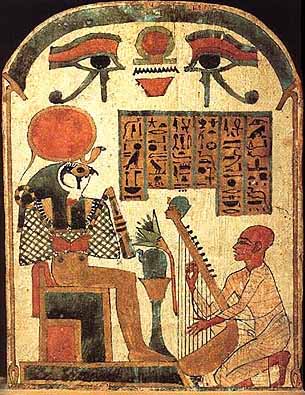
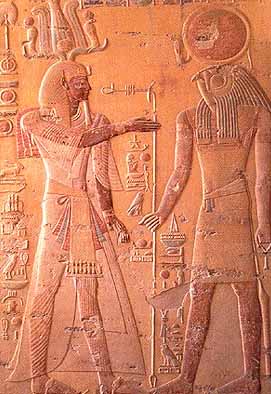
Osiris and Re-Horakhty
His local cult began to grow from roughly the second dynasty, establishing Ra as a sun deity. By the fourth dynasty the pharaohs were seen to be Ra's manifestations on earth, referred to as "Sons of Ra". His worship increased massively in the fifth dynasty, when he became a state deity and pharaohs had specially aligned pyramids, obelisks, and solar temples built in his honor.
The first Pyramid Texts began to arise, giving Ra more and more significance in the journey of the pharaoh through the underworld.
The Middle Kingdom saw Ra being increasingly combined and affiliated with other deities, especially Amun and Osiris.
During the New Kingdom, the worship of Ra became more complicated and grand. The walls of tombs were dedicated to extremely detailed texts that told of Ra's journey through the underworld. Ra was said to carry the prayers and blessings of the living with the souls of the dead on the sun boat.
The idea that Ra aged with the sun became more popular with the rise of The New Kingdom. Eventually, during the reign of Akhenaten (mid 1350s-1330s), the worship reached the level of "uncompromising monotheism"
Many acts of worship included hymns, prayers, and spells to help Ra and the sun boat overcome Apep. Though worship of Ra was widespread, his cult center was in Heliopolis in Lower Egypt. Oddly enough, this was the home of the Ennead that was believed to be headed by Atum, with whom he was merged. The Holiday of 'The Receiving of Ra' was celebrated on May 26 in the Gregorian calendar.
Though Re lived on in various forms into the Greco-Roman period, his worship gradually deteriorated during the fist millennium. This decline was probably due to the weakening of the kingship under various foreign rulers. Though he continued to be a part of Egyptian theology, he was no longer a part of the peoples living faith. Devotion to Re became more and more limited to priests of the temple.
The rise of Christianity in the Roman empire caused an end to worship of Ra by the citizens of Egypt, and as Ra's the popularity suddenly died out, the study of Ra became purely for academic knowledge even among the Egyptian priests.